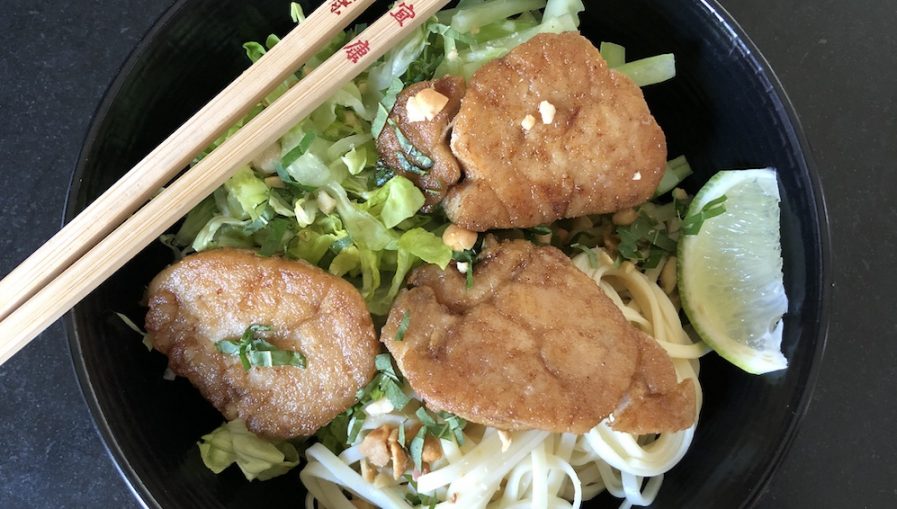In the serious world of French cuisine, Bertrand Simon stands out from the crowd. Known as Chef Simon thanks to the popularity of his website of the same name, and the books he has authored, he learned his craft while working in some of France’s most renowned restaurants, before breaking away from the scene in order to share his knowledge with others.
As he prepares to celebrate 20 years of the Chef Simon website – which now attracts around 50 million visitors each year – Chef Simon generously took time out to share his philosophy on food, and why he’s such a fan of macadamias.

The sensorial surprise of macadamias
Chef Simon recalls his first experience with macadamias back in the early 1980s. It occurred in the form of a brownie with macadamias and pecans in a restaurant that specialised in American and Canadian cuisine. Suffice to say, the macadamia instantly captured his attention.
“When you eat a macadamia nut, it’s like a surprise in the mouth – not necessarily crunchy, but more melting,” he says. “It’s a fabulous ingredient for which I’ve created many recipes. It brings exoticism and modernity.”
For Chef Simon, the macadamia’s mouthfeel, buttery texture and abundance of natural oils are its greatest assets.
“I really like using them in classic desserts like nougatine and brownies, but also in cakes and breads,” he says. “Their good fat content allows you to do interesting things with them because they carry other flavours really well. They go really well with spices, and it’s an aesthetically pleasing nut too.”.
He also loves using macadamias to upgrade traditional recipes, like peanut butter. “I prefer macadamia butter. I use a mixture of raw and roasted macadamias to give it a little crunch. It’s a great combination,” he reveals.
Likewise, he swaps out sesame paste for macadamia paste when making hummus, preferring the flavour the macadamias deliver.
So what is Chef Simon’s favourite use for macadamias? “I would have to say my Vietnamese bo bun recipe. I make it using macadamias instead of peanuts – it tastes amazing.”

Inspiration fuelled by curiosity
For Chef Simon, inspiration for food comes from many sources, including books and music.
“Inspiration comes naturally through the curiosity to find new ingredients, and being open to cooking differently,” he says.
One of his greatest sources of inspiration are his students. For more than 30 years, Chef Simon has taught free cooking classes at a French high school, where he delights in meeting young people of all nationalities. As well as educating his students in the strict French tradition, Chef Simon encourages them to embrace the new, to experiment and question as they cook.
“I learn a lot from my students. They’ll introduce me to ingredients I haven’t worked with before and push me out of my comfort zone,” he reveals.
“It’s one of the reasons I love French cuisine with a foreign influence, such as Asian or Middle Eastern flavours. I’m also a fan of cooking on the kamado – a ceramic grill from Japan that allows you to cook slowly over charcoal.”
Consumers want simple pleasure
Chef Simon believes that right now we’re seeing consumers returning to simplicity, fuelled in part by extended periods in lockdown in response to the COVID-19 pandemic.
“Consumers are looking for new points of reference, simpler, less pedantic cuisine,” he says.
“There is also a growing awareness of the quality of products and the impact this can have on health. A desire for the art of living, a choice of good ingredients, transformed simply for the pleasure of it,” he says.
Continuing to push boundaries
Since freeing himself from the ‘straightjacket’ of academic French cuisine all those years ago, Chef Simon’s influence and popularity have gone from strength to strength.
A flexitarian with a deep interest in the origins and environmental impact of the ingredients he chooses, Chef Simon is committed to providing a totally unique style of content and education that celebrates cuisine as a unifying subject.
“Cuisine is a vector of cultural interest. It’s like a blotting paper of global culture which allows us to be open to other cultures and techniques,” he says.
While it’s impossible to say for sure where consumer trends will take us in the future, Chef Simon’s signature style of old world cuisine fused with emerging culinary ideas will undoubtedly continue to challenge the status quo of food culture – hopefully with plenty of macadamias in the mix.


